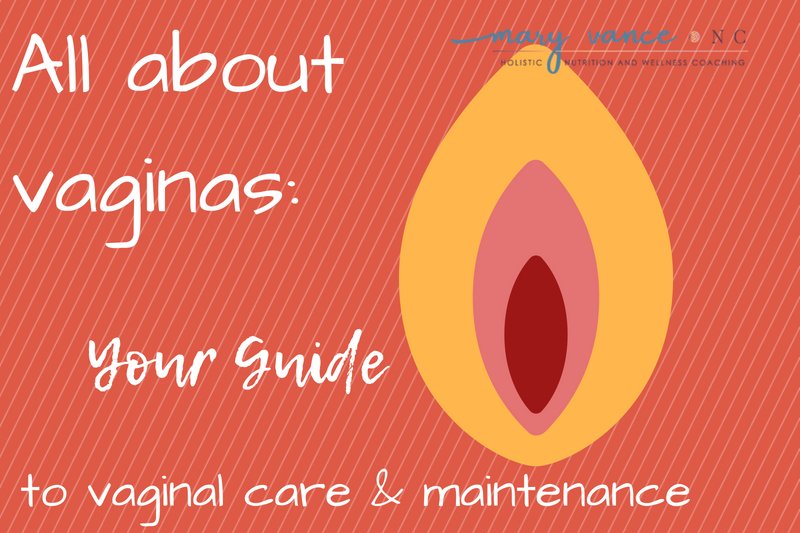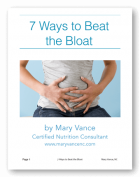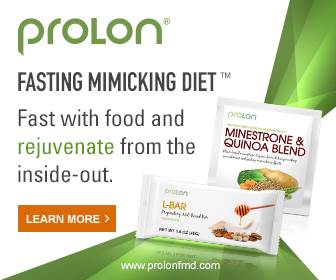When I started health and nutrition coaching in 2005, I worked almost exclusively with women and focused on women’s health. It amazed me how little women in general know about their vaginas and how to care for them. After all, talking about “your privates” is pretty taboo in our culture. So, let’s talk about vagina care, balance, and maintenance. Please share this post with your daughters, sisters, friends, and even your mothers. It’s time we shatter the vagina taboo. Use this guide as a resource to get a dialogue going about vaginal health, or if no one’s told you how to care for yours, this post is for you.
The Vaginal Ecosystem
Roughly 50 percent of us have a vagina, and we need to know how to care for it properly. Just like your eyes, your boobs, and your gut, your vagina has its own microbiome, and there are definitely things that may alter or damage its ecosystem.
The vagina is a complex environment that fluctuates and changes throughout a woman’s life. During the fertile years, the environment in there changes almost weekly throughout the follicular, ovulatory, luteal, and menstrual phases. A healthy vagina is full of friendly bacteria, mainly strains of the lactobacillus species. These good bacteria protect your vag and keep it healthy.
Hormonal fluctuations affect beneficial bacteria levels and vaginal pH, meaning the vagina feels different during various phases of the menstrual cycle: juicier when you’re fertile mid-cycle and drier and more sensitive just prior to menstruation. Ideally, there is a strong population of good bacteria so your body can easily bring vaginal pH back to normal.
For menopausal and post-menopausal women, the vaginal environment is drier and more fragile with lower levels of good bacteria. Diet, herbs, and topical creams help keep vaginal tissues feeling good in the post-menopausal years.
Vagina Ecology
The vagina has its own microbiome with a specific pH and groups of bacteria that keep it healthy. Quick reminder: the pH is a scale that indicates the acidity and alkalinity. The range goes from 0 to 14, with 0 being the most acidic and 14 being the most alkaline.
Lactobacillus is one of the most important groups of bacteria that helps keep the natural balance in most women (interestingly this may vary by ethnicity). NOTE: when you hear “delicate” or “natural balance” it usually refers to the lactobacillus colonies and the pH. Anything that chronically disrupts the pH or alters the colonies of bacteria in there can lead to infection.
Things that disrupt vaginal ecology:
- antibiotic use
- diet high in sugar, processed foods, alcohol
- certain meds like birth control pills, steroids
- douching
- sprays
- scented tampons
- detergents and soaps
- low levels of lactobacillus
Disruptions can cause infections, urinary tract infections (UTIs), painful sex, irritation, dryness, and even infertility (if it makes the vaginal ecosystem inhospitable for sperm).
Lactobacillus regulates vaginal pH by producing lactic acid, which in turn keeps yeasts, bad bacteria, and other organisms in check. Lactobacillus bacteria also help to keep the vaginal wall healthy by promoting mucus production (discharge) that provides a protective barrier against other bacteria, yeasts, and viruses. (source).
Your vagina is a self-cleaning machine/device/oven. The vagina is designed to keep itself clean with the help of natural secretions called discharge that eject germs and bacteria. So don’t wash those away with soaps or douches! You need them. And while we’re at it, all vaginas have an odor, typically a mild musky or earthy aroma. It varies based on your body and pheromones, but it shouldn’t be fishy or offensive. Get to know your smell, because abnormal odor (for you) can be a first indicator that something is off.
Vagina pH
Your vagina is an acidic environment that should be somewhere between 3.8-4.5 to prevent infection and irritation. Yeast (AKA candida) and atypical bacteria in the vagina, for example, prefer a slightly more alkaline environment and tend to proliferate when the pH rises and becomes a more hospitable environment for pathogenic bacteria to grow. Infections are caused when lactobacillus colonies in the vagina dwindle and pathogenic bacteria and fungus grow out of control.
Bacterial vaginosis (BV) and yeast infections are the most common vaginal infections and occur when the pH of the vagina is unbalanced. (source) Elevated vaginal pH can be caused by your period (blood is alkaline at around 7.4 – 7.6); sex with dudes (semen has a pH between 7-8); douching or feminine washes; hormonal fluctuations in your cycle or with menopause; and/or even irritating laundry detergents or soaps. Your diet and medications matter, too: antibiotics, too much sugar, and alcohol can disrupt the vaginal pH. You can buy test strips here to check your vaginal pH.
Symptoms of BV include foul (or fishy) odor; grayish or thin discharge (may also be yellow or green); elevated pH; and burning. Yeast infection symptoms include itching; thick, cottage cheese-like discharge that may smell “yeasty”; and burning. If you have chronic vaginal yeast infections, you likely have an imbalance of good to bad bacteria and an overgrowth of candida. Check out my posts about how to get rid of candida here and here. Yeast can be transmitted back and forth between partners, but men cannot catch or give women BV (couldn’t find much info on transmitting BV from woman to woman).
Many women think they have a yeast infection when they actually have BV, which is the most common vaginal infection (1 in 4 women have it). Even worse, covering it up (BV can make a vag smelly) with sprays or douches can make the problem worse by further altering the pH and the ecosystem. In some cases, an antibiotic may be necessary for BV, but first try a boric acid suppository (never take boric acid internally) and a good probiotic formulated for vaginal health with lots of lactobacillus species. Cut sugar, booze, and processed foods, and support your immune system. Garlic supplements and oil of oregano are excellent natural antibacterials that help regulate bad to good bacterial balance.
To restore vaginal pH: apple cider vinegar or baking soda soaks/washes may help restore vaginal pH depending on if you’re too acidic or too alkaline. Increase veggies (esp leafy greens and cruciferous), good fats, probiotics and probiotic foods; eliminate sugar and alcohol. DO NOT use perfumed soaps, gels, and antiseptics, as this can affect the delicate balance inside the vag. Rinse with warm water. Also, use condoms until pH is restored, as sperm makes a more alkaline environment.
Vagina Care & Maintenance
A few tidbits on how to keep your vag happy:
- wipe front to back. This keeps UTI-causing bacteria like e coli out of your vagina and urethra.
- do not use soap in the vagina. Really, all you need is a warm water rinse down there. If that’s not enough, use a very mild soap for the outer parts (your labia and vulva).
- pee after sex to prevent UTI. If you’re trying to get pregnant, let it marinate for about 30 minutes post-coital, then pee.
- for dryness, try coconut oil or Julva, a cream that keep vaginal skin elastic and moist. I recommend this frequently, especially to menopausal women, or anyone with dryness. People rave about it.
- use a menstrual cup. Tampons, even organic ones, disrupt the bacterial balance and pH. NEVER use scented tampons which basically murder your vaginal ecosystem.
- latex from condoms can be an irritant. Lambskin condoms are a better choice, but they do not protect against STDs.
If you suffer with chronic yeast or BV infections, imbalances in your gut flora (dysbiosis), can be a root cause. Rebalancing your gut flora can go a long way to preventing vaginal infections, (source) Try a candida cleanse. Meantime, boric acid suppositories or even inserting lactobacillus probiotic capsules can provide relief and help a lot.
If you get recurrent yeast infection or irritation symptoms prior to your period (due to fluctuating hormone and bacteria levels), do the candida cleanse, stay on a probiotic for 3-6 months, try the boric acid monthly, and apply coconut oil topically. Apple cider vinegar may also help acid-alkaline balance.
Keep in mind that high blood sugar and diabetes can cause recurrent yeast, so get your blood glucose levels tested.
During menopause, a drop in estrogen and progesterone causes changes in vaginal pH that encourages the growth of BV particularly. Support hormone levels during menopause with these recs, and try Julva or coconut oil for relief. Take a probiotic! This one is formulated for vaginal health.
To support a healthy vagina with diet, step away from the sodas, sugary treats, booze, and processed foods. Your vag needs a strong probiotic presence, so take the one I keep recommending, and eat fermented foods that are good for your gut. Get plenty of the aforementioned veggies (leafy greens, cruciferous), good fats like avocado and coconut oil, and take a fish oil supplement every once in a while. It’s good for lubrication all over, and this one supports healthy hormone balance and may reduce PMS symptoms (it’s worked for me). Salmon, sardines, and iodine-rich seafood are also particularly good for women.
Finally, if you’re on hormonal birth control, please consider another method, like a non-hormonal IUD or the fertility awareness method. You can use a fertility tracker to prevent or plan for pregnancy. Hormonal birth control pills have a laundry list of side effects and cause nutrient deficiencies, dysbiosis, and yeast infections. Read my post about how and why to stop the pill here.
With a little love, not a lot of soap, a lot of lactobacillus, and perhaps a menstrual cup, your vaginal ecosystem will thrive.
Pin it!

Mary Vance is a Certified Nutrition Consultant and author specializing in digestive health. She combines a science-based approach with natural therapies to rebalance the body. In addition to her 1:1 coaching, she offers courses to help you heal your gut and improve your health. Mary lives in San Francisco and Lake Tahoe in Northern California. Read more about her coaching practice here and her background here.











Hi, I very much enjoys it when I was reading this post and I want to know you the most interesting thing which my mind grab here is your word selection. ecosystem nice idea your creation is amazing. vaginal care is important for every women but never I read that called it a ecosystem of vagina.
Hi, I am Chris, I would like to know where I can find Julia. Please let me know : I am post-menopausal and I am very dry.
Hi Chris, I assume you mean the Julva cream? It is linked in the post, or: https://www.amazon.com/gp/product/B07KQRY46Y?ie=UTF8&tag=maryvancnutrc-20&camp=1789&linkCode=xm2&creativeASIN=B07KQRY46Y